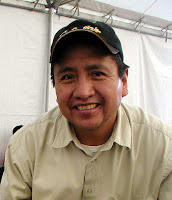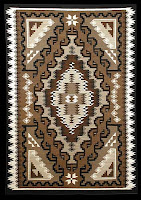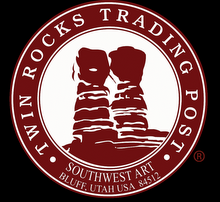
Speaking of the silver and gold jewelry he hand crafts, Allison Lee's captivating voice is sincere when he says, "One time my uncle told me that everything we build comes from the earth, like the silver that comes from the earth, or the turquoise that comes from the earth. That is a lot of energy. You put it together and you put your heart and mind into a piece. Then sometimes a certain piece of jewelry- I believe- it is made for a certain person. I usually have a ring, or something, that stays with me for about two or three years, until the right person comes along. And then that person buys that piece. I believe that every piece of jewelry that I make is made for somebody out there- it's made for somebody special. Whoever might be having problems, or something like that. In essence, that energy helps that person get help, by wearing pieces that we make. That is the way I look at it."
Born in the heart of the Navajo homeland, in the spring of 1958, Allison Snowhawk Lee attended boarding school until 8th grade. Lee is the last name given to him by the boarding school because they couldn't pronounce, spell, or translate his Navajo name; Snowhawk is his grandmother's name.
Allison became involved in silversmithing in a high school art class, making his first simple jewelry pieces at age 12. When he was 14 years old his mother asked him to remove the last stone from an old turquoise brooch and make her a ring with it. Being able to combine old and new into something beautiful gave him a metaphysical sense of bridging generations, connecting him to his heritage and at the same time launching him into a viable vocation.
During his high school summers he worked at silver shops in Gallup, New Mexico. His first job included sweeping floors, but as he worked he became acquainted with the top silversmith, and learned his techniques. Each summer thereafter he found a job in different shops, and studied under various masters. Now he is the master who owns a shop that employs high school age apprentices.
When Allison graduated from high school in 1977 he won the "Most Artistic" award in his class of 160 students. That was just the beginning of his awards. Allison has won numerous honors in prestigious shows in seven different states. He is not only artistic, but very creative, and therein lies his greatest challenge. "A lot of people copy," he says, "and then pretty soon an original idea is being mass produced. I've got to keep ahead of them."
Allison makes many different kinds of jewelry: earrings, necklaces, rings, and bracelets; and is best known for his elaborate concho belts. "I really like making concho belts," he professes, "and coming up with different styles."
Allison uses either silver or, occasionally, 14 karat gold, and sets it with coral, turquoise, or other semi-precious stones. Hand fabricated, his work may be either stamped or contain bezel set stones. His favorite piece was a squash blossom necklace he made using tools he created.
Allison goes on the road two or three times a month, for two or three days at a time, to market his work or attend shows. He also does demonstrations and seminars at Grand Canyon and other places. When he is at work in his shop he may put in up to 16 hours a day. "I take breaks sometimes," he confesses, "Sometimes I get burned out. That's the time to just walk away from it. That's when it's time to go outdoors, just to kind of refresh my mind.
"I go hunting, I go hiking. What I really love to do is go to old Indian ruins and just look around, see what I can find. In a way I get ideas from the old, and then try to come up with something new. Then I get back into it. Everything just starts coming together once I start making something. It just comes together in my mind."
Allison is considered a success by all who are familiar with his work, but he has a different standard, set with his wife and three young sons in mind: "I think being successful is keeping everything balanced out between your family and your work. I think that's what being successful is, caring enough to spend time with your family, and not letting the work and the career overtake your life. I've seen a lot of people that have done that. I'm just glad that I've had people there to tell me the difference. Successful to me is just being happy and making sure my family is fed and clothed. That says it all, right there."



